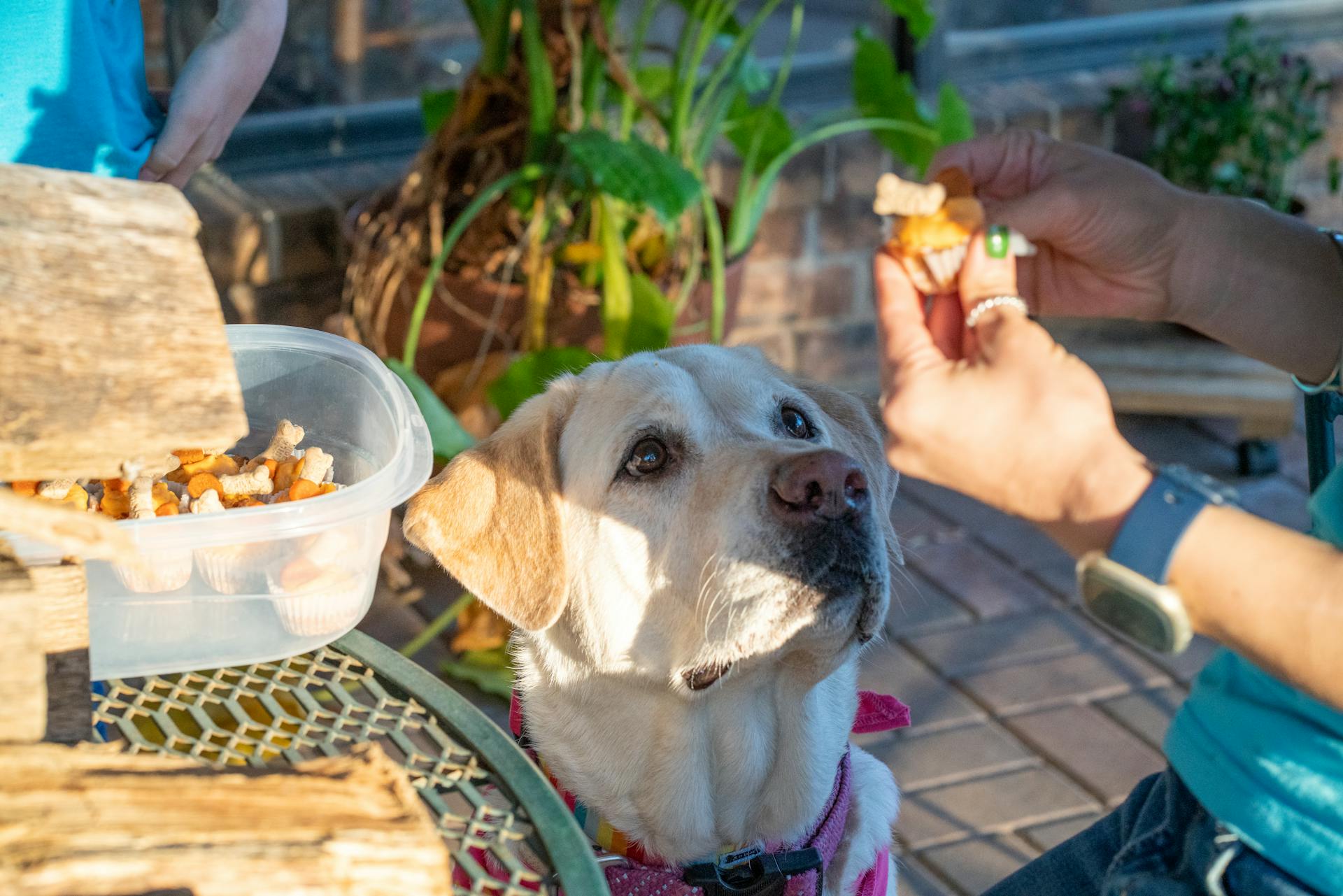
Giving your dog medicine can be a real challenge, but did you know that using dog treats for medicine can make the process a whole lot easier?
Using a treat that masks the taste of the medicine can be a game-changer. For example, peanut butter and pumpkin treats can be used to hide the flavor of liquid medicines.
Some dogs are more finicky than others, but with the right treat, even the pickiest eaters can be convinced to take their medicine.
A study found that using a treat that is high in fat, such as peanut butter, can make the medicine go down more smoothly.
Related reading: Dog Treat Training
Hide the Medicine
You can use a variety of methods to hide your dog's medicine in a treat. One option is to use a pill pocket or paste, which are soft dog treats with a notch cut out to hide the medicine.
Some popular brands of pill pockets include Greenies and Milk Bone, which come in chicken flavor and are easy to use. You can also make your own pill pockets at home using ingredients like peanut butter, oats, and water.
Additional reading: Dog Dementia Medicine
Another option is to hide the medicine in a food item your dog loves, such as peanut butter or soft cheese. Just be sure to use enough treat to cover the pill, and not so much that your dog can chew around it.
Some other foods you can try hiding medicine in include cheese, liverwurst, hot dogs, deli-sliced turkey, baby food meats, canned chicken, cream cheese, yogurt, whipped cream, and cooked sweet potato.
To help your dog swallow the treat and medicine, use one hand to hide the pill and your other hand to seal the treat and offer it to your dog. Make sure your dog completely swallows the treat and medicine, and avoid giving them the same food or treat every time they get medicine to prevent them from developing an aversion.
Here are some tips for hiding medicine in a treat:
- Use a malleable food that can be easily broken into small pieces
- Only use enough treat to cover the pill
- Use one hand to hide the pill and your other hand to seal the treat
- Make sure your dog completely swallows the treat and medicine
- Offer the selected food or treat at other times throughout the day to prevent your dog from developing an aversion
Some foods to avoid hiding medicine in include those that can be toxic to dogs, such as chocolate. Always check with your veterinarian before trying a new food or treat to ensure it is safe for your dog.
DIY Solutions
I was thrilled to discover that making my own dog pill pockets at home is super easy and cost-effective. It's a win-win for both my furry friend and my bank account.
You'll need just a few simple ingredients to get started, such as water, creamy peanut butter (make sure it's free from xylitol, which can be toxic to dogs!), and quick oats. I've found that using peanut butter is a great way to disguise the pill, and it's a treat my dog loves.
Making your own pill pockets at home is a great way to save money, as you won't need to purchase separate treats to hide the pills. I've found that it's also a convenient option, especially when you're on-the-go.
Here are three simple no-bake recipes you can try with your dog:
These recipes are all easy to make and require minimal ingredients. Simply mix everything together, roll out small balls, and press a dog pill into the center. Cover it over and refrigerate until firm. Your dog will be none the wiser!
Frequently Asked Questions
What to use instead of pill pockets?
You can use peanut butter or cottage cheese as alternatives to pill pockets, by hiding the pill inside and serving it to your dog as a treat.
Sources
- https://www.thewildest.com/dog-health/how-to-give-a-dog-a-pill
- https://post.bark.co/food/best-dog-treats-for-pills-medicine/
- https://www.365daysofbakingandmore.com/homemade-dog-pill-pockets/
- https://www.vet.cornell.edu/departments-centers-and-institutes/riney-canine-health-center/canine-health-information/how-medicate-your-dog
- https://fixmealittlelunch.com/hide-dogs-pills-simple-no-bake-dog-treats/
Featured Images: pexels.com


